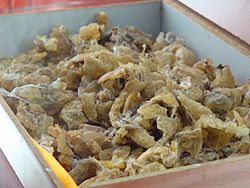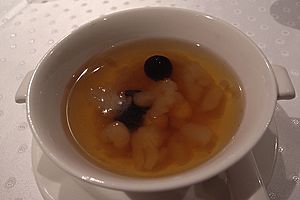Hasma facts for kids

Dried hasma, sold in a box
|
|
| Alternative names | Harsmar, hashima, toad oil |
|---|---|
| Place of origin | China |
| Region or state | Heilongjiang, Jilin, and Liaoning |
| Main ingredients | Fatty tissue found near the fallopian tubes of true frogs |
| Hasma | |||||||||||
|---|---|---|---|---|---|---|---|---|---|---|---|
| Chinese | 1. 雪蛤 2. 雪蛤膏 |
||||||||||
|
|||||||||||
| Alternative Chinese name | |||||||||||
| Chinese | 哈士蟆 | ||||||||||
|
|||||||||||
Hasma (also called harsmar or hashima) is a special ingredient used in Chinese and Central Asian desserts. It comes from a specific part of true frogs, usually the Asiatic grass frog. Because it looks white, people often call hasma "snow frog fat." Hasma is quite expensive, so it is often saved for special events or served in fancy restaurants.
Contents
Where Does Hasma Come From?
Hasma is mostly produced in three provinces in China: Heilongjiang, Jilin, and Liaoning. Long ago, hasma was a special food enjoyed by the Chinese emperors. Today, you can find soups made with hasma in many cities around North America that have large Chinese communities. It is also popular in Mainland China, Taiwan, Singapore, and Hong Kong, though it still costs a bit more than other desserts.
What Does Hasma Look Like?
When you buy hasma, it is usually dried. It comes in flat, uneven pieces and flakes. These pieces are about 1 to 2 centimeters long and 1 to 5 millimeters thick. They are yellowish-white and look a bit dull. Sometimes, they might have a thin, off-white skin on them.
When you add water to dried hasma, it can grow a lot! It can become 10 to 15 times bigger than its dried size.
Taste and Texture of Hasma
Dried hasma, or hasma that has been soaked in water, has a slight smell that reminds you of fish. When it's cooked without extra flavors, it tastes a little sweet and a little savory. Its texture is soft, chewy, and light. It's quite similar to the texture of tapioca pearls you might find in some desserts.
How to Prepare Hasma Desserts

Hasma is often used in sweet soups called tong sui. It adds a unique texture to these soups. It also makes the soup feel more special and fancy. These sweet soups are usually flavored with rock sugar. Even though it sounds exotic, eating hasma in a dessert is a pretty easy and enjoyable experience. You can find hasma in many dessert dishes at high-class restaurants in Hong Kong.
Popular Pairings with Hasma
Hasma is often served in sweet soups with other tasty ingredients:
- Jujubes (Chinese: 紅棗; pinyin: hóng zǎo; literally "red date"), which are sweet red dates.
- Dried longan fruits (Chinese: 龍眼; pinyin: lóng yǎn; literally "dragon eye"), which look like small, clear grapes when dried.
- Lotus seeds (Chinese: 蓮子; pinyin: lían zǐ), which are crunchy and slightly sweet.
Hasma is also a key ingredient in a dessert called "Three Snow Soup" (Chinese: 三雪湯; pinyin: sān xuě tāng). This soup includes:
- Chinese pear (Chinese: 雪梨; pinyin: xuě lí; literally "snow pear"), a type of sweet pear.
- Snow fungus (Chinese: 雪耳; pinyin: xuě ěr; literally "snow ear"), a type of edible mushroom that looks like white coral.
Sometimes, hasma can even be found in more unique versions of shark fin soup.
See also
 In Spanish: Hasma para niños
In Spanish: Hasma para niños

